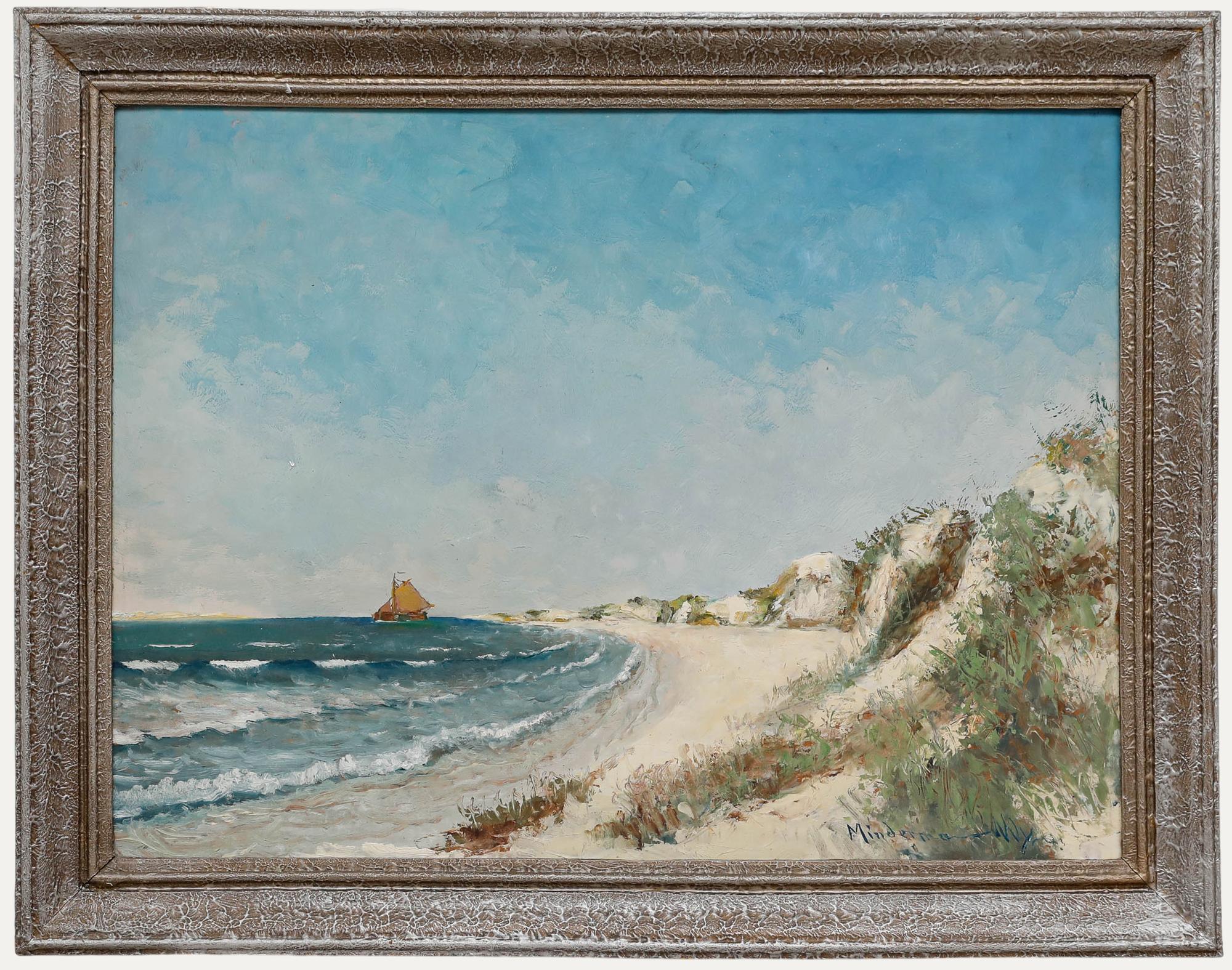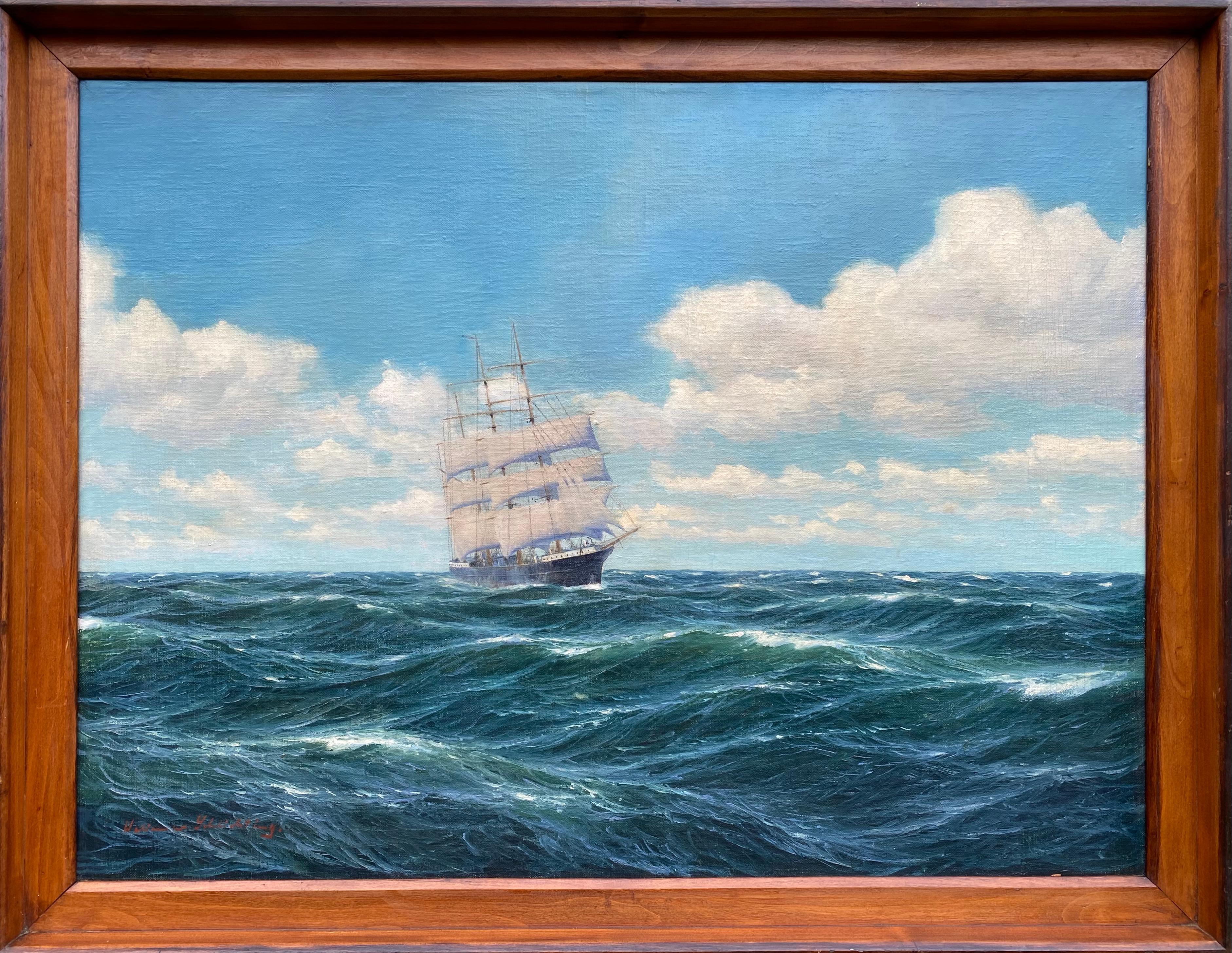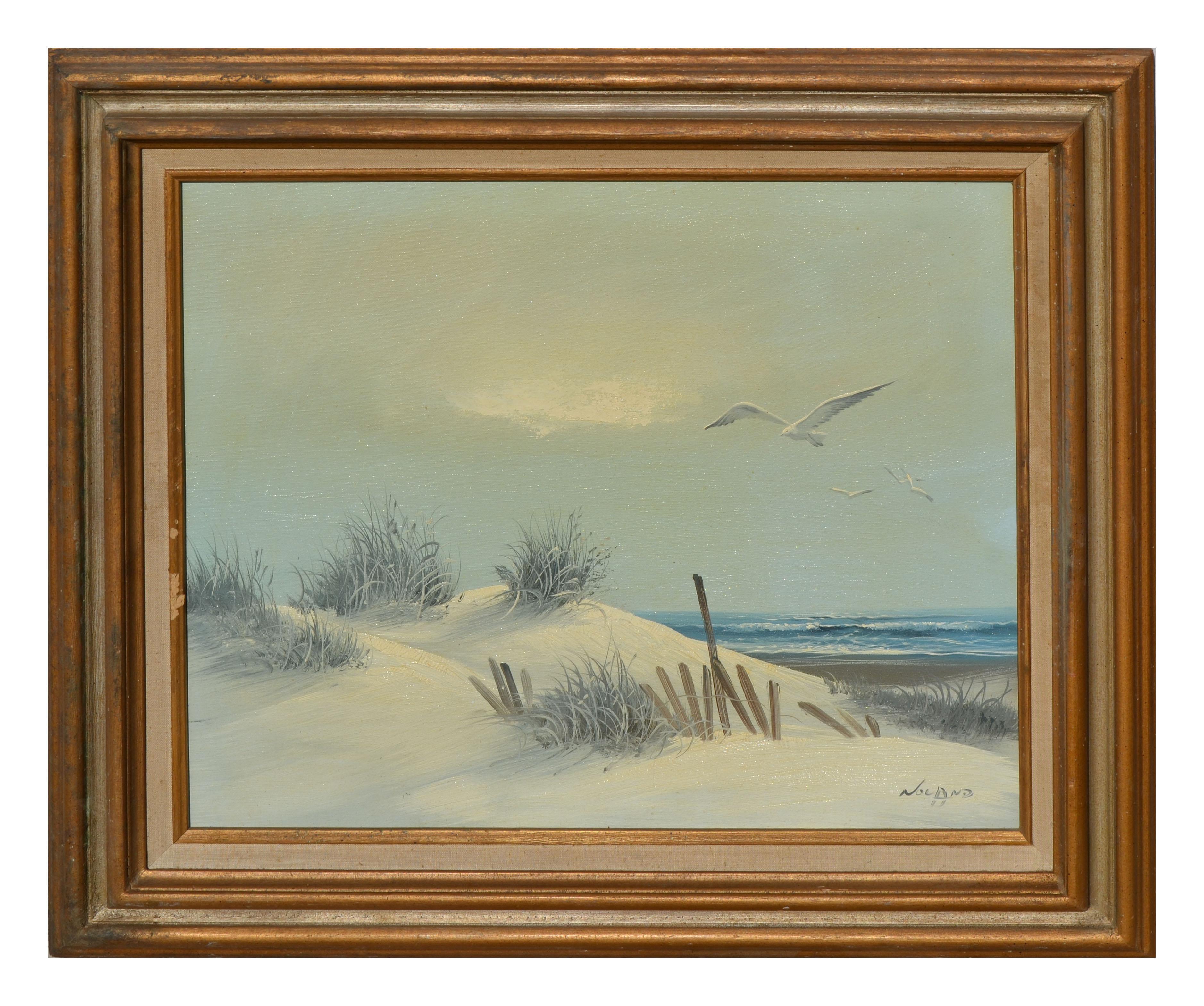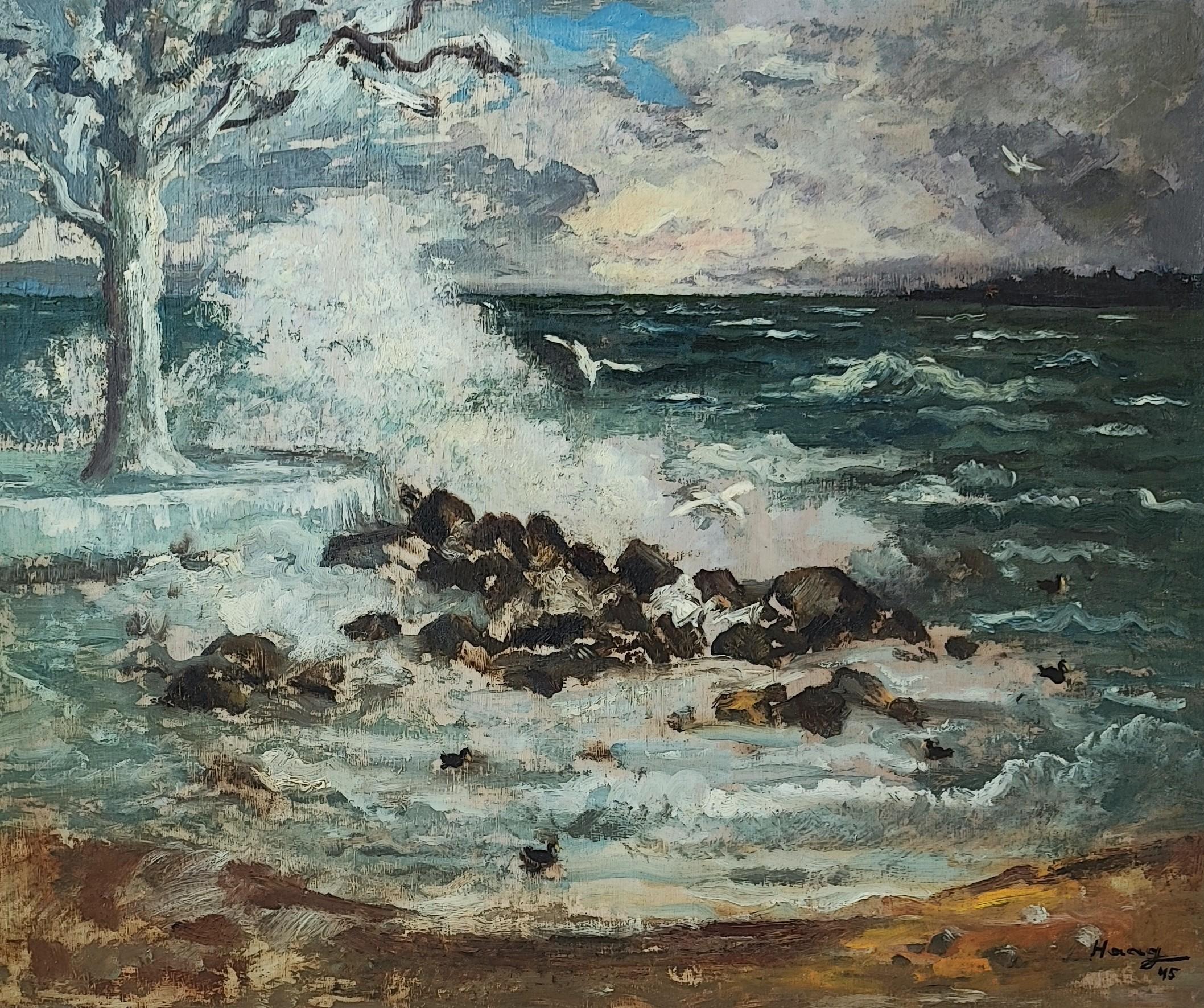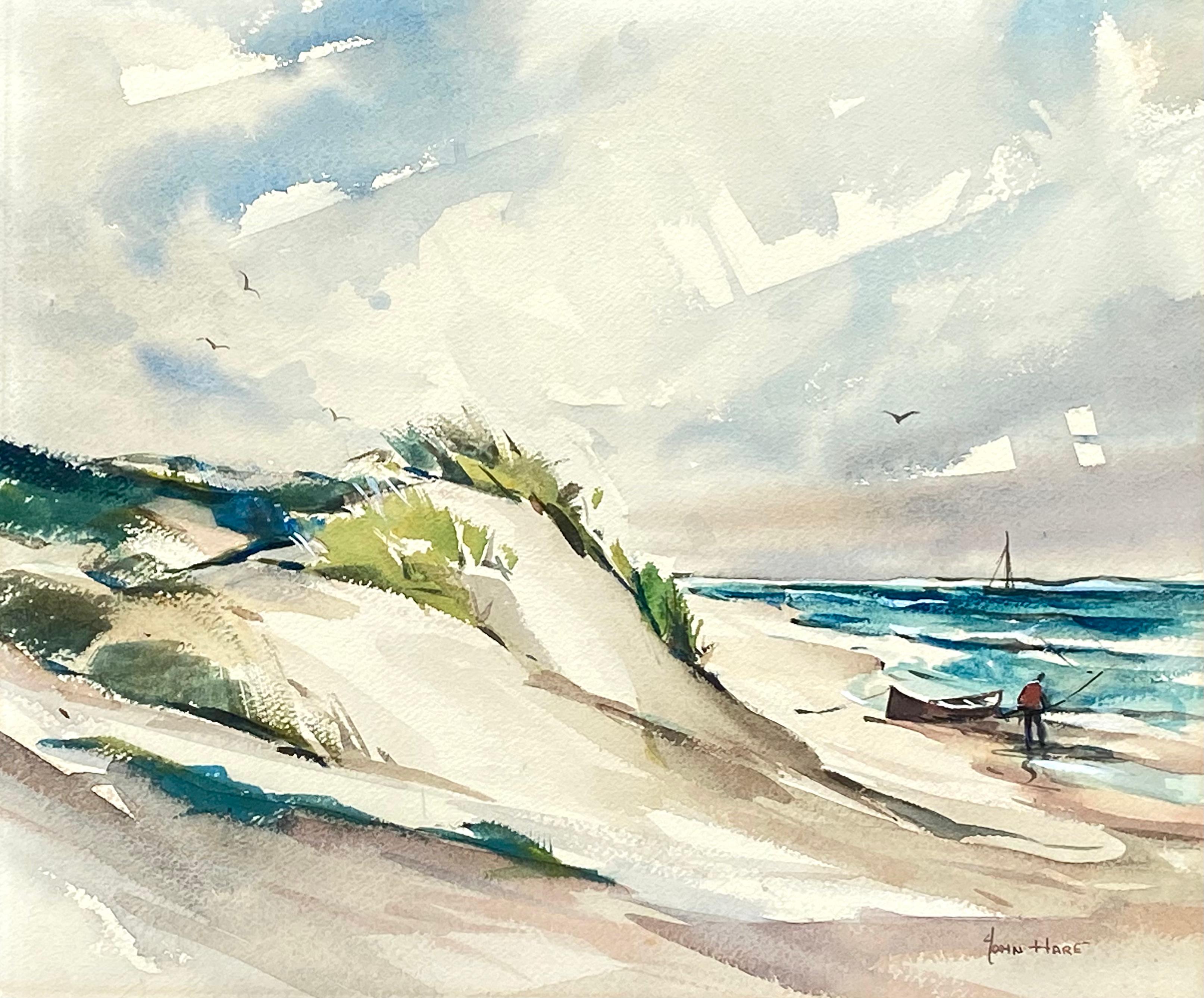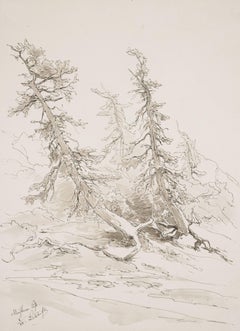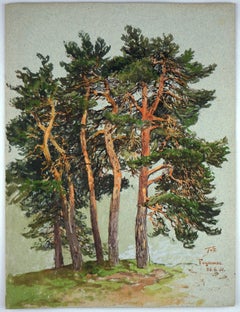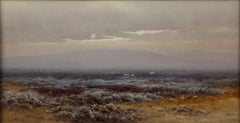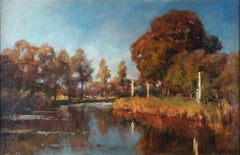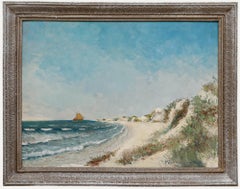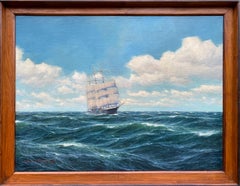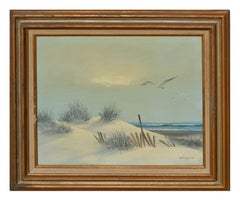Items Similar to Wind Dodgers at the Baltic Sea / - The Sensuousness of the Baltic Sea -
Want more images or videos?
Request additional images or videos from the seller
1 of 9
Theodor ScheerbaumWind Dodgers at the Baltic Sea / - The Sensuousness of the Baltic Sea -1955
1955
$554.77
$693.4620% Off
£410.69
£513.3720% Off
€464
€58020% Off
CA$767.66
CA$959.5720% Off
A$846.32
A$1,057.9120% Off
CHF 442.77
CHF 553.4620% Off
MX$10,382.83
MX$12,978.5320% Off
NOK 5,573.59
NOK 6,966.9920% Off
SEK 5,212.19
SEK 6,515.2420% Off
DKK 3,534.47
DKK 4,418.0820% Off
About the Item
Theodor Scheerbaum (1897 Reichenbach im Vogtland), Wind Dodgers at the Baltic Sea. Watercolor on strong yellowish grained paper, 44 x 56 cm, signed by hand "Th[eodor] Scheerbaum" at lower left and dated by hand "1955". Provenance note on verso. Included is the original mounting board with the handwritten title of the painting.
- in good condition
- The Sensuousness of the Baltic Sea -
About the artwork
The large watercolor depicts a view of the Baltic Sea. From the top of a dune we look at the slightly churned sea, with foaming waves breaking on the shore. The view is framed by wind-shaped pines, the eponymous wind dodgners. The trees, however, are far more present than just framing the view; they have moved so far into the picture that they become a main motif. With virtuoso brushwork, Scheerbaum has rendered the trees in their characteristic appearance. We see the reddish-brown trunks, the branches with their filigree twigs shaped by the constant wind as they grow, and, most impressively, the needles moving in the wind. We can hear the wind whispering in the trees, accompanied by the rhythmic sound of the breaking waves and the cries of the seagulls circling above. Even how the wind passes through the grasses of the dunes becomes tangible, while in the sky the spectacle of the clouds takes place.
The color impressions also take us to the Baltic Sea: The reddish-brown and dark green of the pines, combined with the paler green and brown of the grasses, are as characteristic as the blue-green shimmer of the sea, which harmonizes in color with the sky and the sand. To enhance the impression of the sand, the artist chose a yellowish paper, the basic tone of which characterizes the entire scene.
Theodor Scheerbaum has captured the seascape in all its sensuousness, creating a pictorial epitome of the Baltic Sea. Directly in front of us, almost blown traces in the sand invite us to enter this iconic Baltic Sea landscape.
GERMAN VERSION
Theodor Scheerbaum (1897 Reichenbach im Vogtland), Windflüchter an der Ostsee, Aquarell auf starkem gelblichem genarbtem Papier, 44 x 56 cm, links unten mit „Th[eodor] Scheerbaum“ handsigniert und auf „1955“ handdatiert. Rückseitiger Provenienzvermerk. Beiliegend die ursprüngliche Montagepappe mit dem handschriftlichen Bildtitel.
- in gutem Zustand
- Die Sinnlichkeit der Ostsee -
zum Kunstwerk
Das großformatige Aquarell eröffnet einen Ausblick auf die Ostsee. Von einer Düne aus blicken wir auf die leicht bewegte See mit ihren schäumend am Stand auslaufenden Wellen. Gerahmt wird der Ausblick von windgeformten Kiefern, den namensgebenden Windflüchtern. Die Bäume sind jedoch weit präsenter als bloß eine Rahmung des Ausblicks zu sein, sie sind so weit ins Bild gerückt, dass sie zu einem Hauptmotiv werden. Mit virtuoser Pinselführung hat Scheerbaum die Bäume in ihrer charakteristischen Erscheinung zur Darstellung gebracht. Wie sehen die rotbräunlich aufscheinenden Stämme, die vom beständig wehenden Wind in ihrem Wachstum geformten Äste mit ihren filigranen Zweigen und – besonders beeindruckend – das im Wind bewegte Nadelwerk. Wir hören geradewegs den Wind in den Bäumen flüstern, begleitet vom rhythmischen Rauschen der auslaufenden Wellen und den Schreien der darüber kreisenden Möwen. Selbst wie der Wind durch die Gräser der Dünen fährt wird erfahrbar, während sich am Himmel das Schauspiel der Wolken vollzieht.
Auch in den Farbeindrücken finden wir uns ganz und gar an die Ostsee versetzt: Das Rotbraun und Dunkelgrün der Kiefern in Verbindung mit dem helleren Grün und Braun der Gräser ist ebenso charakteristisch wie das blaugrünlich schimmernde Meer, das farblich mit dem Himmel und dem Sand harmoniert. Um den Eindruck des Sandes zu verstärken, hat der Künstler ein gelbliches Papier gewählt, dessen Grundton die gesamte Szenerie prägt.
Theodor Scheerbaum hat die Meereslandschaft in der ganzen Fülle ihrer Sinnlichkeit ins Bild gesetzt und damit einen bildlichen Inbegriff der Ostsee geschaffen. Genau vor uns zeichnen sich beinahe verwehte Spuren im Sand ab, die dazu einladen, in diese ikonische Ostseelandschaft hineinzulaufen.
- Creator:Theodor Scheerbaum (1897, German)
- Creation Year:1955
- Dimensions:Height: 17.33 in (44 cm)Width: 22.05 in (56 cm)Depth: 0.4 in (1 cm)
- Medium:
- Movement & Style:
- Period:
- Condition:
- Gallery Location:Berlin, DE
- Reference Number:1stDibs: LU2438212834002
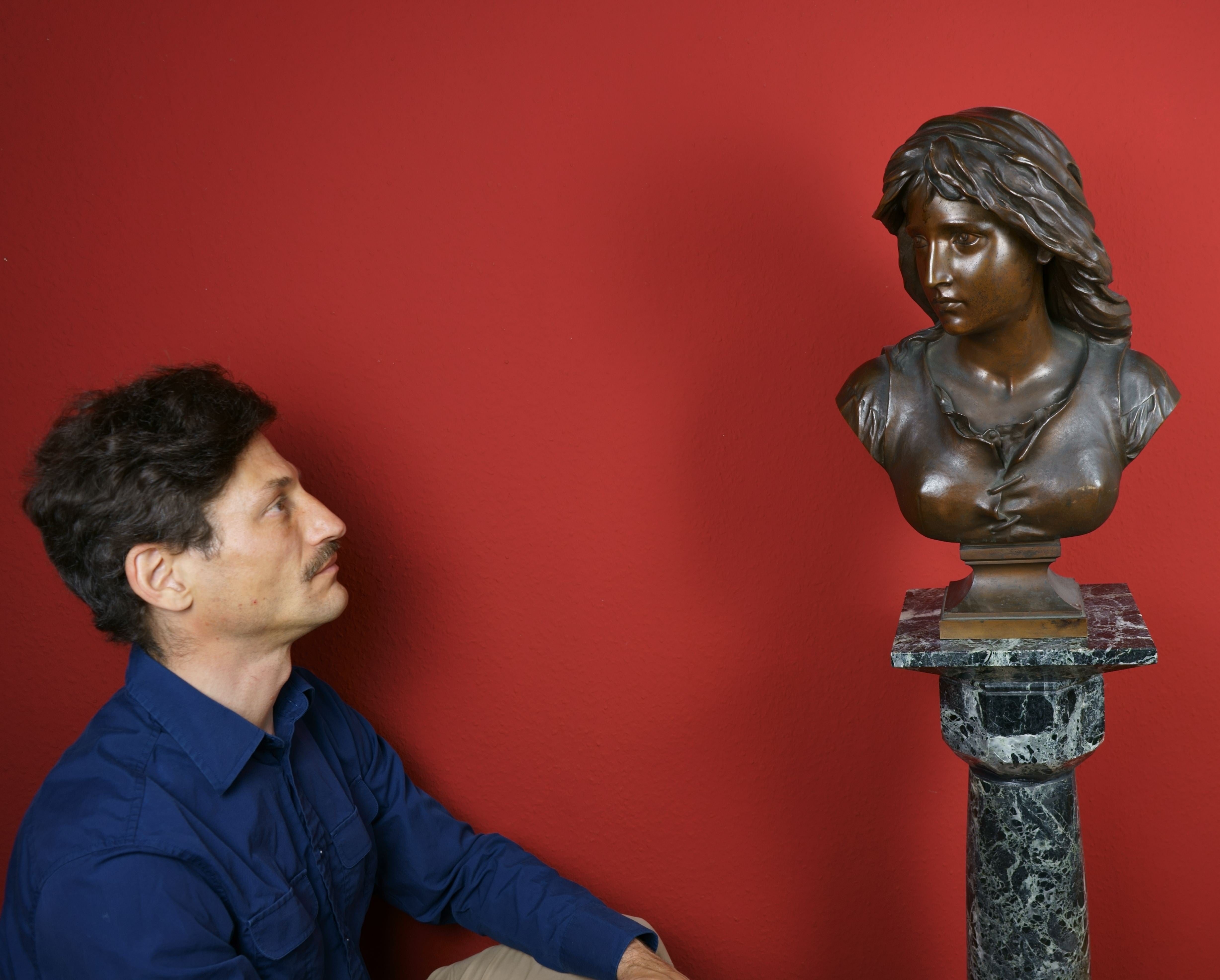
About the Seller
5.0
Vetted Professional Seller
Every seller passes strict standards for authenticity and reliability
Established in 2014
1stDibs seller since 2023
21 sales on 1stDibs
- ShippingRetrieving quote...Shipping from: Berlin, Germany
- Return Policy
Authenticity Guarantee
In the unlikely event there’s an issue with an item’s authenticity, contact us within 1 year for a full refund. DetailsMoney-Back Guarantee
If your item is not as described, is damaged in transit, or does not arrive, contact us within 7 days for a full refund. Details24-Hour Cancellation
You have a 24-hour grace period in which to reconsider your purchase, with no questions asked.Vetted Professional Sellers
Our world-class sellers must adhere to strict standards for service and quality, maintaining the integrity of our listings.Price-Match Guarantee
If you find that a seller listed the same item for a lower price elsewhere, we’ll match it.Trusted Global Delivery
Our best-in-class carrier network provides specialized shipping options worldwide, including custom delivery.More From This Seller
View AllWoodland / - The Inner Drama of the Landscape -
Located in Berlin, DE
Eduard Peithner von Lichtenfels (1833 Vienna - 1913 Berlin), Woodland, 1884. Watercolor and pen and ink on drawing paper, 30.4 cm x 22.5 cm, signed, dated and inscribed by the artist...
Category
1880s Landscape Drawings and Watercolors
Materials
Paper
Norwegian Pine Grove - The inner glow of the trees -
Located in Berlin, DE
Themistokles von Eckenbrecher (1842 Athens - 1921 Goslar), Norwegian pine grove, 1901. Watercolor on blue-green paper, 30 x 22 cm. Signed, dated and inscribed in his own hand "TvE. Fagermes [i.e. Fagermes]. 26.6.[19]01."
- Slight crease throughout at left margin, otherwise in good condition.
About the artwork
Themistokles von Eckenbrecher often traveled to Norway to study the nature that fascinated him there. On June 26, 1901, near the southern Norwegian town of Fagernes, in the summer evening sun, he saw a small pine grove, which he immediately captured in a watercolor. He exposed the trees growing on a small hill in front of the background, so that the pines completely define the picture and combine to form a tense motif. The tension comes from the contrast of form and color. The trunks, growing upward, form a vertical structure that is horizontally penetrated by the spreading branches and the pine needles, which are rendered as a plane. This structural tension is further intensified by the color contrast between the brown-reddish iridescent trunks and branches and the green-toned needlework.
Themistokles von Eckenbrecher, however, does not use the observed natural scene as an inspiring model for a dance of color and form that detaches itself from the motif and thus treads the path of abstracting modernism. Its inner vitality is to be brought to light and made aesthetically accessible through the work of art.
It is precisely in order to depict the inner vitality of nature that von Eckenbrecher chooses the technique of watercolor, in which the individual details, such as the needles, are not meticulously worked out, but rather a flowing movement is created that unites the contrasts. The trees seem to have formed the twisted trunks out of their own inner strength as they grew, creatingthose tense lineations that the artist has put into the picture. The inner strength continues in the branches and twigs, culminating in the upward growth of the needles. At the same time, the trunks, illuminated by the setting sun, seem to glow from within, adding an almost dramatic dimension to the growing movement.
Through the artwork, nature itself is revealed as art. In order to make nature visible as art in the work, von Eckenbrecher exposes the group of trees so that they are bounded from the outside by an all-encompassing contour line and merge into an areal unity that enters into a figure-ground relationship with the blue-greenish watercolor paper. The figure-ground relationship emphasizes the ornamental quality of the natural work of art, which further enforces the artwork character of the group of trees.
With the presentation of Themistokles von Eckenbrecher's artistic idea and its realization, it has become clear that the present watercolor is not a study of nature in the sense of a visual note by the artist, which might then be integrated into a larger work context, but a completely independent work of art. This is why von Eckenbrecher signed the watercolor. In addition, it is marked with a place and a date, which confirms that this work of nature presented itself to him in exactly this way at this place at this time. At the same time, the date and place make it clear that the natural work of art has been transferred into the sphere of art and thus removed from the time of the place of nature.
About the artist
Themistocles' parents instilled a life of travel in their son, who is said to have spoken eleven languages. His father, who was interested in ancient and oriental culture, was a doctor and had married Francesca Magdalena Danelon, an Italian, daughter of the British consul in Trieste. During a stay in Athens - Gustav von Eckenbrecher was a friend of Heinrich von Schliemann and is said to have given him crucial clues as to the location of Troy - Themistokles saw the light of day in 1842.
After an interlude in Berlin, where Themistokles was educated at the English-American School, the journey began again. From 1850 to 1857 the family lived in Constantinople, after which the father opened a practice in Potsdam, where Themistokles, who wanted to become a painter, was taught by the court painter Carl Gustav Wegener.
In 1861 the von Eckenbrechers left Potsdam and settled in Düsseldorf. There Themistokles received two years of private tuition from Oswald Aschenbach, who greatly admired the talented young artist. After his artistic training, he undertook extensive travels, often accompanied by Prince Peter zu Sayn-Wittgenstein, which took him to northern and eastern Europe, but above all to the Middle East and even to South America. The paintings that resulted from these journeys established his artistic reputation and led to his participation in large panoramas such as the 118 x 15 metre Entry of the Mecca Caravan into Cairo, painted for the City of Hamburg in 1882.
1882 was also the start of a total of 21 study trips to Scandinavia, most of them to Norway, and the unique Norwegian landscape with its rugged fjords became a central motif in his work. Along with Anders Askevold and Adelsteen Normann...
Category
Early 1900s Naturalistic Landscape Drawings and Watercolors
Materials
Watercolor
$1,147 Sale Price
20% Off
High Moorland Landscape in the fog - The world as a transcendent phenomenon -
Located in Berlin, DE
Charles Edward Brittan Jr (1870 Plymouth - 1949). High moor landscape in the fog. Gouache, signed at lower left "Charles E. Brittan", 18 x 34.5 cm (passepartout), 45 x 62 cm (frame)....
Category
Early 20th Century Realist Landscape Drawings and Watercolors
Materials
Watercolor
$1,721 Sale Price
20% Off
Late Summer River Landscape / - Realistic Impression -
By Jan Hillebrand Wijsmüller
Located in Berlin, DE
Jan Hillebrand Wijsmuller (1855 Amsterdam - 1925 ibid.), Late Summer River Landscape, oil on canvas, relined, 34 x 56 cm (inside measurement), 43 x 64 cm (frame), signed J[an] H[illebrand] Wijsmuller at lower right.
- in good condition, the frame with isolated bumped spots
- Realistic Impression -
About the artwork
The panoramic landscape format shows a river landscape, with the course of the river, which curves to the right, leading the eye into the depths of the picture and tempting it to continue the landscape in the imagination beyond the visible area. At the same time, however, the fact that the landscape is not visible through the bend in the river focuses our gaze on the entirety of the landscape depicted, without prompting us to focus on distant details. Accordingly, the brushstroke is not designed to render details with realistic precision. In the front left area of the river there is even a completely free brushwork, trained by Impressionism, which nevertheless remains committed to representational and convincingly suggests the movement of the water.
Regardless of the distance of the observer, the entire picture is painted with the same broad brushstroke, so that the landscape is given as an impression. And yet this impression is not ephemeral, as in the case of French Impressionism, to put it exaggeratedly, but reveals to us the essence of the landscape in all its richness. This is why the Dutch variant of Impressionism is always also a realism, although the pictures appear less progressive, but still contain a dimension of landscape painting that is lost with progress.
In the impression, the reality of the landscape is revealed, and this happens as we experience the landscape in the visual impression. Wijsmuller does not depict houses or people in order to allow the experience of the landscape to fully unfold. The experience is determined first and foremost by the river, which does not flow into the picture from our point of view, but towards us. Where the river begins to bend, the water is churned by a rapids. Toward us, the riverbed widens and the water comes to rest, covering the entire width of the foreground like a mirror.
The stillness of the water corresponds to the evening mood of the late summer landscape, in which the warm tones of the evening light blend with the yellow and brown tones of the plants. A gentle, almost idyllic reality, carried by the brushstroke, yet animated by a liveliness that is also made visible by the brushstroke. The broad, dynamically placed brushstrokes evoke the movement of the treetops and animate even the immobile reeds, while the trunks on the right bank, executed in virtuoso white strokes that seem like markings, make the sunlight shine. On the other bank, a carpet of light also spreads out, its energetic effect again expressed in the brushstroke. The dynamic of the landscape is further enhanced by the complementary color contrasts between the greens, yellows, and browns on the one hand and the blue of the all-encompassing sky on the other. A contrast that is intensified by the reflection in the water.
The evening coming to rest of the landscape is thus at the same time an all-encompassing contrasting and yet in itself harmonious movement. This reality becomes accessible to us as an experience in the impression of the landscape.
About the artist
Jan Hillebrand Wijsmuller entered the Royal Academy of Arts in Amsterdam in 1876 and studied under the innovative Professor August Allebé, who was famous for the Amsterdam Impressionism, also known as the Allebé School.
In 1877, Wijsmuller transferred to the Hague Academy of Art, and thus to the Hague School, and then completed his studies at the Brussels Academy of Art. Returning to the Netherlands, Wijsmuller opened his own studio in Amsterdam.
In 1883 he won the prestigious Young Artist Award, donated by Willink van Collen, which made Wijsmuller a well-known and sought-after artist.
Wijsmuller was a member of the Societät Arti et Amicitiae Amsterdam and the Pulchri Studio in The Hague.
Wijsmuller belongs to the second generation of the Hague School. While Vincent van Gogh described the protagonists of the first generation to his brother Theo as "the great gray people," the second generation, and Wijsmuller in particular, used a much more colorful palette. His oeuvre makes him a major player in Dutch Impressionism...
Category
1890s Impressionist Landscape Paintings
Materials
Canvas
$3,634 Sale Price
20% Off
Autumn verso Summer Landscape / - Imagined Landscape -
Located in Berlin, DE
Seidel, Herbert (1906-1974), Autumn verso Summer Landscape, 1953
Herbert Seidel (1906 Berlin - 1974 Rüdersdorf), Autumn verso Summer Landscape, 1953. India ink on grained, bleached p...
Category
1950s Abstract Landscape Drawings and Watercolors
Materials
Paper
In the forest of Durlach - Quiet ripple in a secret place -
Located in Berlin, DE
Franz Xaver Graessel (1861 Oberasbach/Baden - 1948 Emmering). In the forest of Durlach. 1881. Pencil drawing, heightened with white, on grey-green paper. 33 x 41.7 cm. Signed, dated and inscribed by the artist himself: 'Franz Graessel. Durlach, 12 April 1881".
About the artwork
The drawing depicts a view of the woods which, as if sharpening the visual focus, remains diffuse at the edges and does not allow the viewer to locate himself in the picture. As a result, the landscape appears to be an apparition, but at the same time it is given real substance by the solidity of the massive arched bridge made of quarry stone. As the main motif of the painting, the bridge, which blends in with nature like an archaic relic, also acts as a visual guide, drawing attention to the white, raised waters of the stream and the surrounding vegetation. The diffusion of perception that takes place there, however, draws the eye back to the bridge and thus to the overall view. This movement initiating a constant alternation of diffusion and concretion, which is the specific tension of the painting that brings the landscape to life. The materialisation and dematerialisation, however, does not take place solely through the eye's wandering through the picture; it is simultaneously linked to the viewer's approach to and distance from the picture, which loses its richness of detail precisely in the close-up, only to reconfigure itself with increasing distance.
In this work, which dates from Graessel's studies in Karlsruhe, the artist reflects on the emergence of pictorial objectivity. Here, however, nature is more than a mere motif. The real connection between culture and nature is symbolically expressed by the choice of green paper.
The drawing is an impressive testimony to Graessel's mastery of the sprezzatura with which he skilfully applies the most abstract of strokes, which visibly merge towards the centre of the picture. The signature and the exact date prove that Graessel gave this work more than the character of a mere sketch.
About the artist
Franz Graessel grew up in an environment that was to nourish his later key motifs: his parents' house was a mill. After attending the Karlsruhe Academy of Art from 1878 to 1884, where he studied under Carl Hoff, Graessel continued his training at the Munich Academy from 1886 to 1890 as a pupil of Wilhelm von Lindenschmidt. Trained primarily in genre and portrait painting, he initially portrayed the life of Black Forest farmers. From 1894 he turned increasingly to animal painting, concentrating on the depiction of ducks and geese, which earned him the nickname 'Enten-Graessel'. Graessel's work thus parallels that of Alexander Koester...
Category
1880s Naturalistic Landscape Drawings and Watercolors
Materials
Chalk, Pencil, Paper
$2,295 Sale Price
20% Off
You May Also Like
Heinz Mindermann - 20th Century Oil, The Coast of Norderney
Located in Corsham, GB
This coastal landscape painting depicts a serene seashore scene with rolling waves washing onto a sandy beach, while a small sailing vessel with distinctive reddish-brown sails navig...
Category
20th Century Figurative Paintings
Materials
Oil
Free Sea - Baltic Sea, Painting, Watercolor on Watercolor Paper
By Marko Fenske
Located in Yardley, PA
Painted on location in July 2020 at Baltic Sea near Kolberg, Poland :: Painting :: Contemporary :: This piece comes with an official certificate of authenti...
Category
21st Century and Contemporary Contemporary Drawings and Watercolor Paint...
Materials
Watercolor
Sailing the Waves, Waldemar Schlichting, Berlin 1896 – 1970, German, Signed
Located in Knokke, BE
Sailing the Waves
Schlichting Waldemar
Berlin 1896 – 1970
German Painter
Signature: Signed bottom left
Dimensions: Image size 61 x 81,50cm, frame size 69,50 x 89,50 cm
Medium: Oil ...
Category
Mid-20th Century Realist Landscape Paintings
Materials
Canvas, Oil
Calm Winds - Peaceful California Seascape
Located in Soquel, CA
Peaceful landscape of sand dunes along a California beach with seagulls drifting overhead in a soft gray-blue sky, by a California artist. Signed "Noland" lower right. Presented in a...
Category
Late 20th Century American Impressionist Landscape Paintings
Materials
Canvas, Oil
Wind on the lake
Located in Genève, GE
Work on canvas
Wooden frame
69 x 77.5 x 5.5 cm
Category
1940s Landscape Paintings
Materials
Oil
“Cape Cod Dunes”
By John Cuthbert Hare
Located in Southampton, NY
Here for your consideration is a very finely executed watercolor by the New England artist, John Cuthbert Hare of the dunes of Cape Cod, Massachusetts. Condit...
Category
1960s Post-Impressionist Drawings and Watercolor Paintings
Materials
Watercolor, Archival Paper
More Ways To Browse
Castle Chillon
Charles Culver Paintings
Charles De Wolf Brownell
Crashing Waves Watercolor
Helen Allingham
Hugh Ferriss
Joseph Southall
Pencil Drawings Canadian
Susan Van Campen
Thomas Knight
Thomas Schaller
Andrew King
Ann Mccoy
Beatrice Parsons
Concorde Drawing
E Ambrose Webster
George Price Boyce
Nachshon Lithograph
